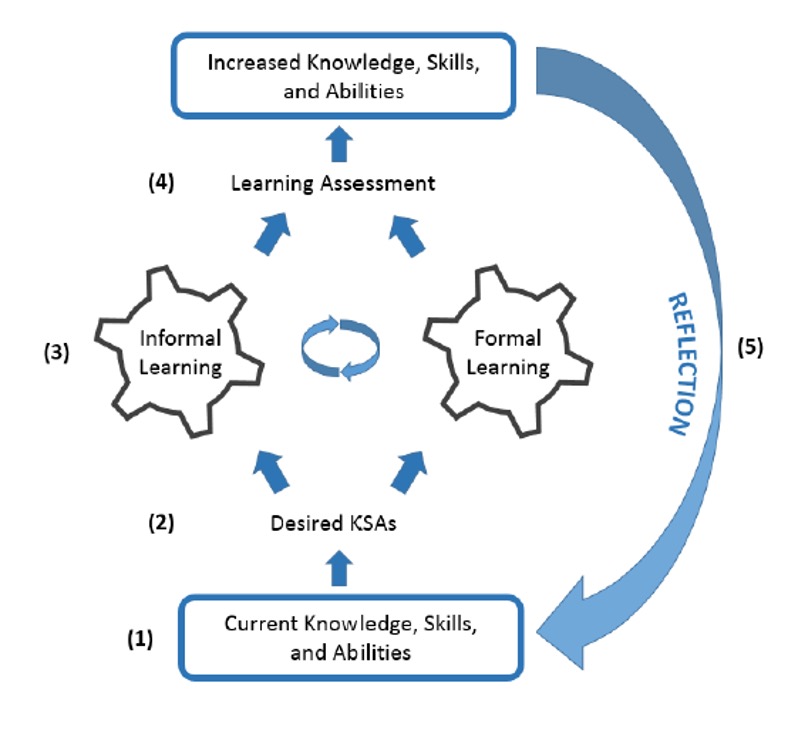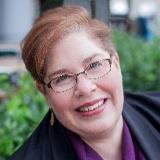Using the Self-Determined Professional Development Cycle© for Intentional Professional Growth
Many of my career positions have required a set amount of professional development each year. However, I have generally received few guidelines on which topics or activities to prioritize. I grew tired of putting off required development to the last moment and having few choices or guidance, so I decided to start taking an intentional approach to my own professional development.
I created the Self-Determined Professional Development Cycle© (SDPDC) to help myself and others maximize the professional development experience. The cycle is based on the theories of adult learning (andragogy) and self-determined learning (heutagogy). The SDPDC can be applied to technical (hard) or interpersonal (soft) skill development and is not limited to a specific timeframe or topic. In addition, the SDPDC incorporates the concept of capability as well as competency. Capability is demonstrated when new competencies (knowledge, skills, and abilities, or KSAs) are applied to unfamiliar situations, and is obtained through intentional reflection on learning. Capability takes competent professionals to the next level of growth and should be actively sought.
As Figure 1 shows, the SDPDC consists of a five-stage cycle that includes multiple opportunities for self-reflection.
Stage One is both a starting and ending point in the cycle. Here, you should take the time to identify where you are currently as a professional in terms of KSAs. Questions you might ask yourself include:
- What tasks make up my current job role?
- Do these tasks require hard skills, soft skills, or both?
- Are there tasks where I feel less than comfortable completing an assignment?
- What is the source of my discomfort?
If you are new to a role and unsure how to evaluate your current level of KSAs, reach out to your manager, a trusted mentor, or the organizational entity responsible for professional development. By the end of Stage One, you should have a foundation of self-knowledge that you can use in Stage Two.
In Stage Two, you use the self-knowledge gained from Stage One to identify specific learning goals. Perhaps you want to increase your level of current KSAs, or you’re interested in expanding into new areas. This is also a good time to set learning goals within appropriate timeframes. Given the large amount of change even in the past year due to COVID-19, I suggest you focus on the next 1 to 2 years. Questions you might ask yourself include:
- Where am I now, and where do I think I want to be?
- What are the KSAs required for my future self?
- Knowing my current level of KSAs, where do I have areas of potential growth?
- What are some short and mid-term learning goals that will take me in the direction of my future self?
Even if you didn’t reach out to others in Stage One, this is definitely a time to get other perspectives. You don’t want to miss opportunities due to tunnel vision. At the end of Stage Two, you should have identified some learning goals. Don’t overwhelm yourself. Focus on the next few steps. After all, you may change your mind as you learn more.
Stage Three is where you research, select, and implement learning opportunities. Everyone has their own preferred learning environment and whenever possible, you want to select learning opportunities that will be most beneficial to you in terms of acquired competency and learning environment. To identify learning opportunities, you can reach out to internal learning resources, professional organizations, educational institutions, and even Google to uncover other opportunities. As you examine your options, consider questions, such as:
- Do I prefer to learn on my own or with others?
- Do I prefer formal learning experiences that are highly structured and led by an instructor, or do I prefer more informal learning experiences?
- How much time do I have to participate in learning opportunities?
- How much financial support will I receive for participating in learning opportunities?
The best professional development opportunities will match your financial situation, available time, and learning preferences in addition to meeting your learning goals. Be intentional in your selection.
Stage Four occurs as you complete your selected professional development. Assess your learning throughout the process by asking questions such as:
- Am I focused on learning or am I trying to multi-task learning concurrently with other responsibilities?
- Can I answer questions correctly and consistently without referring to my notes?
- Can I complete practice tasks in a reasonable amount of time without undue reliance on my notes?
- Do I feel comfortable sharing what I’ve learned with others?
Oftentimes, professional development stops with Stage Four. We complete required learning, check the task off our to-do list, and move on without further thought. In doing so, we miss an opportunity to maximize our learning experience and our own development.
Stage Five incorporates active self-reflection on your learning.
Stage Five is important because it completes the cycle, leading back to Stage One where you identified your current level of KSAs. Questions to consider in Stage Five include:
- Did I meet my learning goals?
- Was the learning environment a good match for me?
- How can I apply what I learned to current or potential work projects?
- What did I learn that I didn’t expect?
- Am I still focused on the same career goals as before, or do I want to consider a different direction?
As Stage Five leads back to Stage One, you begin the cycle of professional development anew, with an intentional review of where you are now and where you want to be.
Utilizing the SDPDC will help you make intentional professional development choices. Utilizing the SDPDC does not require extended amounts of time but it does require active reflection and awareness of one’s areas of potential growth. In today’s ever changing and increasingly complex work environment, I hope you will find the SDPDC to be as beneficial as I have.
Note:
The SDPDC can also be utilized by managers to create intentional learning plans for individual employees or work teams.
Figure 1. Self-Determined Professional Development Cycle© (Smith, 2019a).

Suggested Resources
Smith, K. D. (2019a, April). New to SAS®? Helpful hints for developing your own professional development plan. Paper presented at the SAS Global Forum 2019, Dallas, Texas. Available at https://tinyurl.com/2h9hzx2j
Smith, K. D. (2019b, October). Need to develop your employees’ SAS® Skills? A step by step framework. Paper presented at the SouthEast SAS Users Group 2019, Williamsburg, Virginia. Available at https://tinyurl.com/b2259dka
Smith, K. D. (2021, May). Tips for providing effective and budget-friendly SAS® development in a remote environment. Paper presented at the SAS Global Forum 2021 (virtual). Available at https://tinyurl.com/3n5bf2px
 Kelly D. Smith, Ed.D., is a Senior Research Analyst at Central Piedmont Community College, where she supports student success and equity initiatives through data collection, analysis, and reporting which enables data informed decision making. In addition to her role in Institutional Research, Kelly utilizes her doctorate in Adult and Community College Education to design and develop data literacy training in collaboration with the Center for Teaching and Learning Excellence.
Kelly D. Smith, Ed.D., is a Senior Research Analyst at Central Piedmont Community College, where she supports student success and equity initiatives through data collection, analysis, and reporting which enables data informed decision making. In addition to her role in Institutional Research, Kelly utilizes her doctorate in Adult and Community College Education to design and develop data literacy training in collaboration with the Center for Teaching and Learning Excellence.
